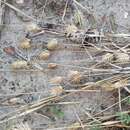Description
provided by eFloras
Culms geniculate at base, 10–30 cm tall, 3- or 4-noded, puberulent below spike. Leaf sheath inflated on upper leaves, glabrous or puberulent at base; ligule 0.5–1 mm, membranous, apex truncate; leaf blade thin, flat, 1.5–8 × 0.2–0.3 cm, both surfaces scabrous or sparsely puberulent. Spike ellipsoid-ovoid or subglobose, contracted, dense, 1–1.7(–2) × 0.6–1.6 cm. Spikelets closely imbricate, green, 6–10 mm, with 3–6 florets, glabrous. Glumes lanceolate, 4–6 mm, thickly keeled, glabrous, apex subulate. Lemma scabrous but first lemma ± puberulent, 5–6 mm, apex acuminate or with short awn 1–1.5 mm; callus ca. 0.4 mm. Palea shorter than lemma, apex 2-dentate. Fl. and fr. Apr–May.
- license
- cc-by-nc-sa-3.0
- copyright
- Missouri Botanical Garden, 4344 Shaw Boulevard, St. Louis, MO, 63110 USA
Distribution
provided by eFloras
Nei Mongol, Xinjiang [Kazakhstan, Kyrgyzstan, Russia, Turkmenistan, Uzbekistan; Europe].
- license
- cc-by-nc-sa-3.0
- copyright
- Missouri Botanical Garden, 4344 Shaw Boulevard, St. Louis, MO, 63110 USA
Habitat
provided by eFloras
Wooded and grassy steppes, dry slopes, semideserts, sands, pebbles, alkaline and saline soils; 800–1400 m.
- license
- cc-by-nc-sa-3.0
- copyright
- Missouri Botanical Garden, 4344 Shaw Boulevard, St. Louis, MO, 63110 USA
Physical Description
provided by USDA PLANTS text
Annuals, Terrestrial, not aquatic, Stems nodes swollen or brittle, Stems geniculate, decumbent, or lax, sometimes rooting at nodes, Stems caespitose, tufted, or clustered, Stems terete, round in cross section, or polygonal, Stem internodes hollow, Stems with inflorescence less than 1 m tall, Stems, culms, or scapes exceeding basal leaves, Leaves mostly basal, below middle of stem, Leaves mostly cauline, Leaves conspicuously 2-ranked, distichous, Leaves sheathing at base, Leaf sheath mostly open, or loose, Leaf sheath smooth, glabrous, Leaf sheath hairy at summit, throat, or collar, Leaf sheath and blade differentiated, Leaf sheath enlarged, inflated or distended, Leaf blades linear, Lea f blade auriculate, Leaf blades very narrow or filiform, less than 2 mm wide, Leaf blades mostly flat, Leaf blade margins folded, involute, or conduplicate, Leaf blades more or less hairy, Ligule present, Ligule an unfringed eciliate membrane, Inflorescence terminal, Inflorescence racemose, Inflorescence simple spikes, Inflorescence a dense slender spike-like panicle or raceme, branches contracted, Inflorescence solitary, with 1 spike, fascicle, glomerule, head, or cluster per stem or culm, Inflorescence spike ovoid, lanceolate, or oblong, not more than twice as long as wide, Inflorescence single raceme, fascicle or spike, Inflorescence spikelets arranged in a terminal bilateral spike, Flowers bisexual, Spikelets sessile or subsessile, Spikelets laterally compressed, Spikelet less than 3 mm wide, Spikelets with 2 florets, Spikelets with 3-7 florets, Spikelets solitary at rachis nodes, Spikelets distichously arranged, Spikelets all alike and fertille, Spikelets bisexual, Sp ikelets disarticulating beneath or between the florets, Spikelets falling with parts of disarticulating rachis or pedicel, Inflorescence branches deciduous, falling intact, Spikelets in dense head-like clusters, Rachilla or pedicel glabrous, Glumes present, empty bracts, Glumes 2 clearly present, Glumes equal or subequal, Glumes equal to or longer than adjacent lemma, Glumes keeled or winged, Glumes 1 nerved, Glume saccate, inflated, or flabellate, Lemma similar in texture to glumes, Lemma coriaceous, firmer or thicker in texture than the glumes, Lemma 5-7 nerved, Lemma glabrous, Lemma body or surface hairy, Lemma apex acute or acuminate, Lemma awnless, Lemma mucronate, very shortly beaked or awned, less than 1-2 mm, Lemma margins thin, lying flat, Lemma straight, Palea present, well developed, Palea membranous, hyaline, Palea shorter than lemma, Palea 2 nerved or 2 keeled, Palea keels winged, scabrous, or ciliate, Stamens 3, Styles 2-fid, deeply 2-branched, Stigmas 2, Fruit - caryopsis, Caryopsis ellipsoid, longitudinally grooved, hilum long-linear, Caryopsis hairy at apex.

